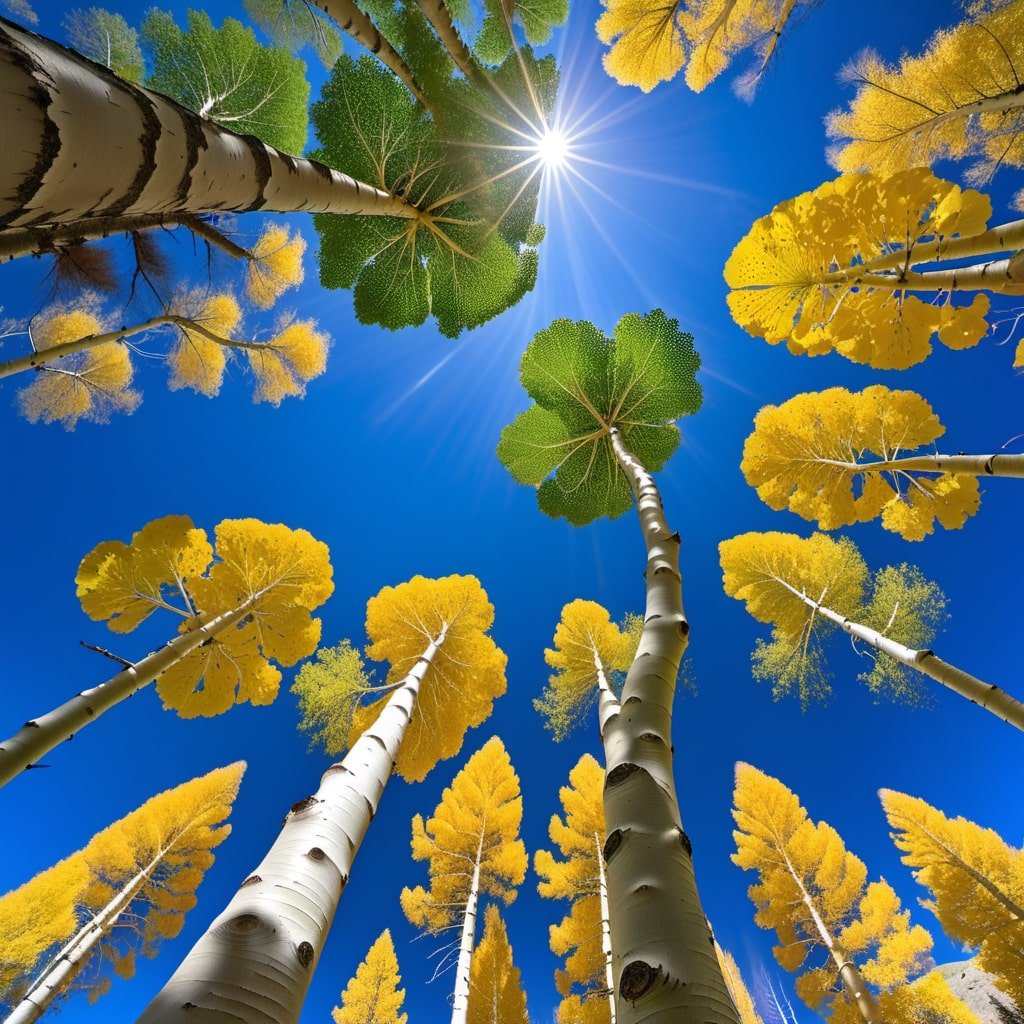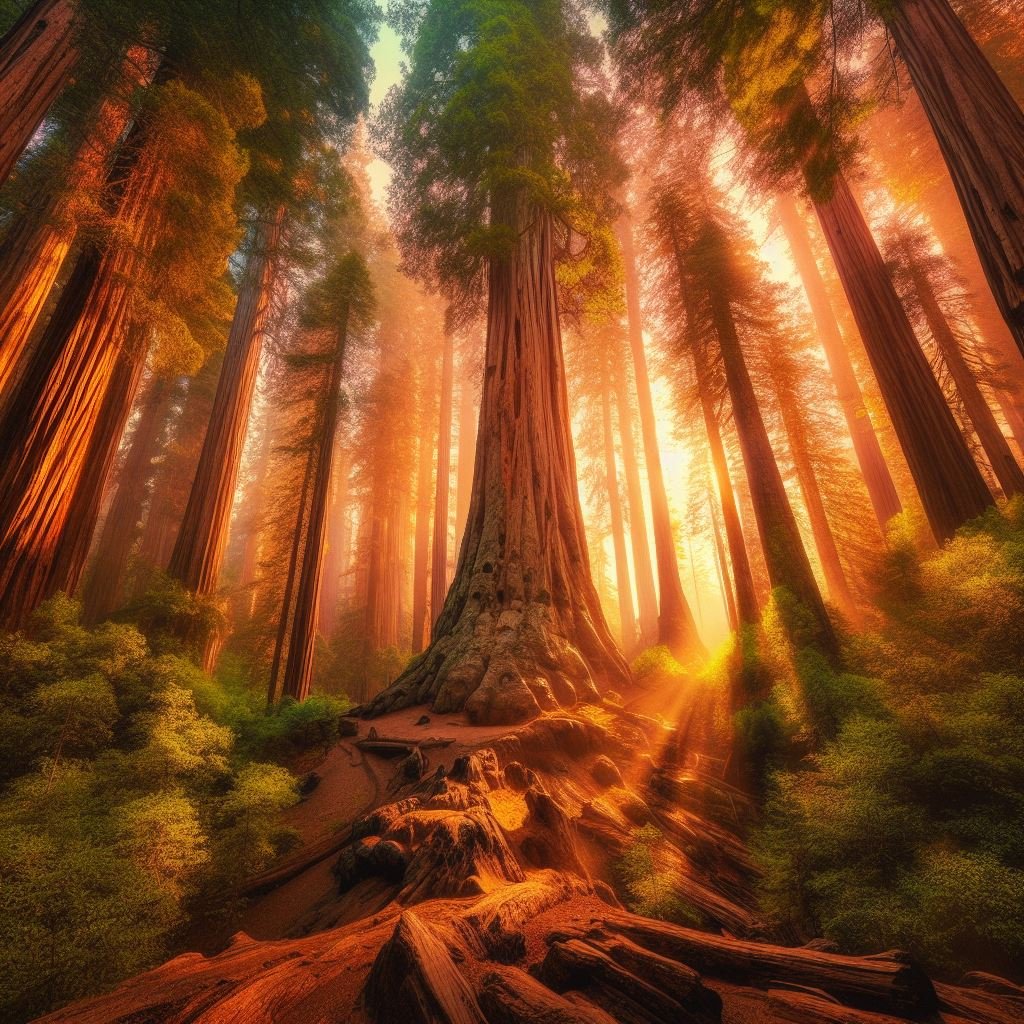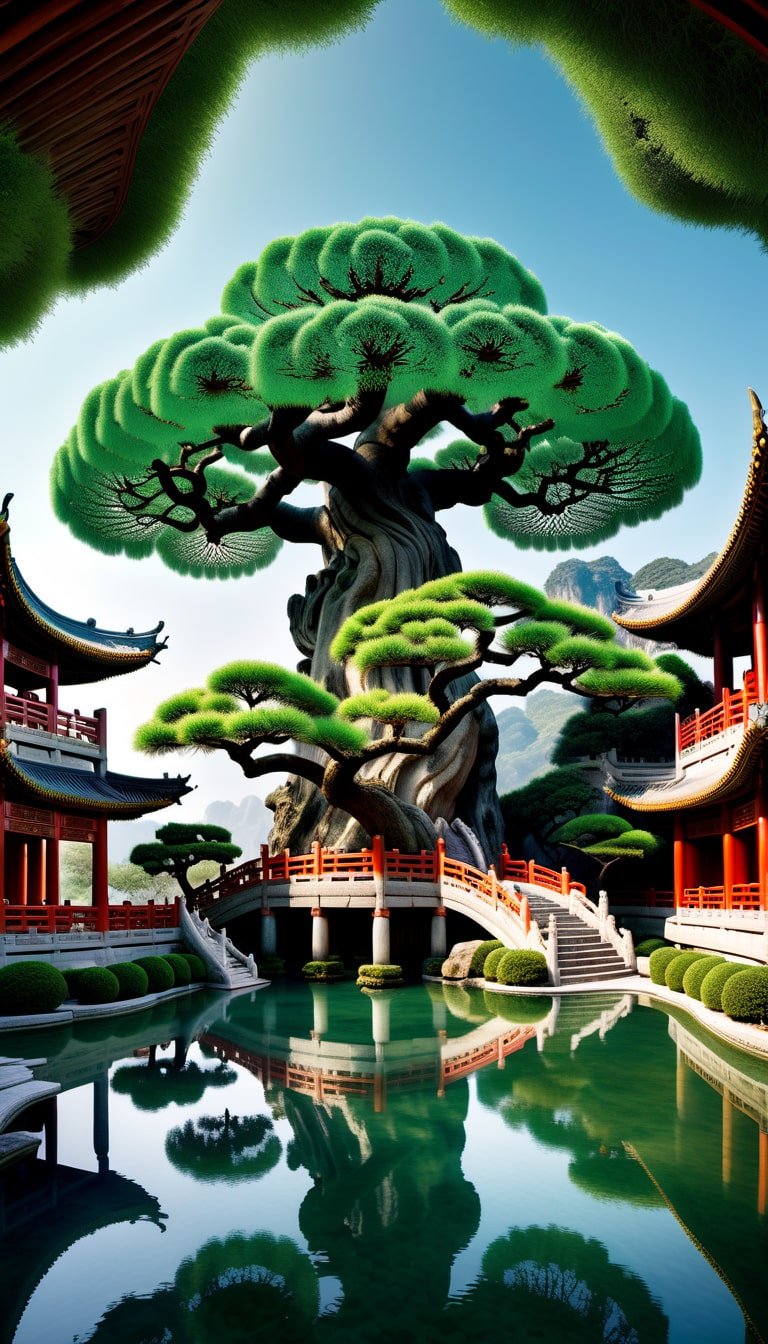Pando: Earth's Heaviest Organism Sings Again
The Ancient Giant Pando Awakens After a Millennia of Silence
Key Takeaways:
Ancient giant trees like Pando play crucial ecological roles and have unmatched cultural heritage value.
Iconic massive trees worldwide include sequoias, mountain ashes, baobabs, kauri, redwoods, banyans.
Only fragments remain of Earth's original extensive old-growth forests due to logging, land clearing, etc.
Sacred significance of trees is a global cultural phenomenon spanning millennia, with rituals, folklore, and spiritual practices.
Major threats to ancient trees include habitat fragmentation, altered fire regimes, climate change, invasive pests, pollution, overharvesting.
Protecting remaining old-growth ecosystems requires policy action on multiple fronts such as expanded protected areas, assisted migration, integrated fire management.
Safeguarding ancient arboreal organisms preserves crucial ecological memory, inspires wonder, and has inherent ethical worth.
In south-central Utah, a majestic organism once thought mute is singing again, thanks to dedicated scientists exploring its ancient voice.
Pando, a quaking aspen clone made up of over 40,000 genetically identical tree stems, is recognized as the oldest, largest and heaviest clonal organism on Earth (DeWoody et al., 2008). This massive forest has towered over Utah’s Fishlake National Forest for over 80 millennia, spreading across 108 acres and weighing over 80,000 tons (Grant et al., 1992).
“Clouds come floating into my life, no longer to carry rain or usher storm, but to add color to my sunset sky.” -Rabindranath Tagore
An Ancient Guardian Awakens
Pando has stood sentry over this landscape since the last Ice Age, enduring thousands of years of droughts, fires, disease and human impacts. Climate models suggest its origins trace back over 80,000 years to the early Holocene period (Mock et al., 2008).
This clone sprouted from a single aspen seed, carried on the wind to take root after the glaciers retreated (DeWoody et al., 2008). As this first seedling spread its roots, it created a massive interconnected system that has persisted through the ages. Despite Pando's great longevity, the average lifespan of individual stems is only around 130 years (USDA Forest Service, 2022).
“When we try to pick out anything by itself, we find it hitched to everything else in the Universe.” -John Muir
Challenges to Survival
In recent decades, Pando has faced multiple threats, including grazing pressure from deer and elk, disease, and climate change (Rogers and Gale, 2017). These impacts have reduced its ability to regenerate new stems, resulting in a shrinking footprint (USDA Forest Service, 2022).
Protective fencing has helped reduce animal browsing, while ongoing stewardship by groups like Friends of Pando aims to boost awareness and support (Friends of Pando, 2022). Though challenged, this ancient forest persists thanks to dedicated care.
“The creation of a thousand forests is in one acorn.” -Ralph Waldo Emerson
Finding Its Ancient Voice
Last year, sound artist Jeff Rice recorded Pando for the first time to explore its acoustic qualities that had never been captured before (Rice, 2022). Using hydrophones placed against tree roots, he picked up the subtle vibrations transmitted under and through the interconnected organism. When even a light breeze stirred leaves in the canopy, Rice recorded a captivating natural symphony sung by Pando after millennia of only silence.
"I was awestruck by the complexity and beauty of Pando's voice," Rice described. "You can hear the whole forest humming and creaking as this one living being. It sounds primordial, like listening to a dinosaur or something prehistoric" (Rice, 2022).
Rice was struck by how attuned and responsive Pando's trees are to the slightest environmental stimuli based on the noises propagating across the shared root system. It demonstrates the complex sensory capabilities of Pando as a unified superorganism.
While Pando appears immutable to short-lived humans, recordings like Rice's give a glimpse of its ongoing growth and life processes. We can literally hear its metabolism and reactions, much as our own bodies make sounds recognized as signs of health by doctors. As a testament to nature's ingenuity, Pando continues thriving through ever-changing eras, each year expanding its root network and woody bulk.
"The wonder of the tree is that though it dies, it yet lives." - George R.R. Martin
Scientific Insights
Studies of Pando's unique genetics reveal valuable insights on longevity, adaptation and forest ecology. Mitton and Grant (1996) found very low genetic diversity between Pando stems, confirming they originate from a single parent. Despite this, the clone displays remarkable resilience, with different stems expressing various adaptive traits needed to survive fires, drought, disease and other stressors (Mock et al., 2008).
Forest ecologists view Pando as an invaluable study system to untangle the complex factors impacting forest health. Long-term monitoring provides data to model aspen population dynamics in response to changing climate, herbivory, pathogens and human actions (Rogers and Gale, 2017). These findings help guide management strategies for protecting aspen ecosystems.
“The tree which moves some to tears of joy is in the eyes of others only a green thing that stands in the way.” -William Blake
Reasons for Hope
While Pando has entered a fragile period, there are ample reasons to believe this ancient forest can persist if stewardship efforts continue. Major threats like browsing have been reduced, and remaining stresses can be managed under ongoing monitoring (Rogers and Gale, 2017).
Pando has endured warm periods equaling or exceeding modern conditions, indicating resilience to climatic changes (Mock et al., 2008). With proactive care, conservationists aim to preserve Pando for many millennia to come.
Our ancient forests represent vital, living links to Earth’s ecological memory.
As Aldo Leopold (1949) stated: “It is a century now since Darwin gave us the first glimpse of the origin of species. We know now what was unknown to all the preceding caravan of generations: that men are only fellow-voyagers with other creatures in the odyssey of evolution.”
In nourishing these most venerable organisms, we nourish our planet’s deep biography. We also kindle our own capacity for wonder, humility and care.
Giant Trees Across the Globe
Pando is but one example of the massive and ancient organisms that have endured across our planet. Several tree species can live for millennia and grow to tremendous sizes.
The giant sequoia is perhaps the most iconic massive tree. The General Sherman Tree in California’s Sequoia National Park is the largest known living sequoia, measuring 83 meters tall with a 11 meter diameter trunk (National Park Service, 2022).
Despite its towering height, General Sherman is a relative youngster at only 2,300-2,700 years old (ibrarian.net, 2022). Giant sequoias can survive over 3,000 years, and historically grew even larger. The Boole Tree, with a trunk over 17 meters wide, is thought to be up to 3,600 years old (Schmid, 2022).
Coast redwoods can also reach enormous dimensions and ages. The tallest known redwood is 115 meters, in Northern California’s Redwood National Park (National Park Service, 2022). Some coast redwood specimens have been dated to over 2,000 years old, but recent studies using tree ring data extended maximum ages past 2,500 years (Sillett et al., 2015). Redwood roots interconnect, potentially making clusters of trees a single genetic organism like Pando.
The tallest on record was a 115 meter specimen named Stratosphere Giant, last measured in 2000 before losing its top. The previous record holder was 112.8 meter Wallace Giant, named after naturalist John Wallace who first located it in 1991 (Van Pelt, 2001).
Redwoods achieve such heights due to favorable climate, few natural predators, and resistance to decay fungi. They expand steadily over centuries rather than grow in rapid spurts (Sillett & Van Pelt, 2007). Interestingly, a mystical phenomenon occurs in old-growth redwood groves – circular ‘fairy rings’ or songomes appear as the trees mature.
These rings can grow over 200 feet wide, formed by redwood root grafting. As neighboring trees connect their roots for stability, they share water, nutrients and chemical signals through the fusion (Anderson, 2019).
“The creation of a thousand forests is in one acorn.” - Ralph Waldo Emerson
Among conifers, the Great Basin bristlecone pine has the most verified ancient individuals. Growing in high mountains of California, Nevada and Utah, bristlecone pines grow glacially slowly in marginal conditions.
The oldest known bristlecone named Methuselah, located in the Ancient Bristlecone Pine Forest of eastern California’s White Mountains, is a gnarled 4,853 year old specimen (Lanner, 2007). Nearby, an unnamed bristlecone is dated to 5,068 years old - the world's oldest known living non-clonal tree (Currey, 1965).
“Time does not relinquish its rights, either over human beings or over mountains.”- Johann Wolfgang von Goethe
The massive Montezuma bald cypress of Mexico’s Oaxaca state may be Earth’s most massive and ancient tree. The widest specimen, called El Árbol del Tule, has a trunk diameter of 11.62 meters and is estimated at 1,400-3,000 years old (American Forestry Association, 2022; Vovides, 2022).
Some contend it may be the oldest single-stemmed tree, but verifying the age of the gnarly giants is difficult. Even larger specimens exist in Oaxaca’s Quiotepec Miranda forest, suggesting bald cypress giants over 4,000 years old (Vovides, 2022).
Giant Eucalyptus of Australia
Australia is home to giant eucalyptus trees that dominate the continent’s woodlands. The mountain ash species produces some of the tallest and most massive individuals. A tree named Centurion in southern Victoria stood 99.6 meters tall before it was felled in 1872 (Barrett, 2022). The tallest living eucalyptus is a 99.2 meter mountain ash named Electra in Tasmania (Giant Trees, 2022).
Unfortunately, extensive clearcutting threatens the towering mountain ash. Victoria’s Central Highlands hosted miles of 100 meter swamp gums prior to colonization. Today, only 4 intact giants remain, the tallest reaching 92 meters.
Though not as tall, the Australian jarrah forest features massive trees spreading up to 15 meters wide. Some jarrah specimens measure over 500 cubic meters in trunk volume (Wardell-Johnson et al., 2015). While eucalyptus trees rarely exceed 500 years old, clonal colonies connected by lignotubers - woody root mats - allow older ages. A large mallee eucalyptus individual named Jutka was dated at over 13,000 years old using carbon dating and growth rings (Clarke et al., 2022).
Subterranean Giants
While trees usually garner the attention, some of Earth’s oldest and largest organisms are underground. The giant puffball mushroom of the Pacific Northwest produces massive fruiting bodies up to 150 cm wide.
Despite their ephemeral above-ground presence, giant puffballs have a permanent root-like subterranean mycelium that persists for centuries. A single 2,400 year old giant puffball mycelium covered 15 hectares, recognized as the world’s largest fungus (Ferguson et al., 2003).
Armillaria species are parasitic fungi that infect tree root systems and grow into extensive mycelial mats in soil. In Oregon’s Malheur National Forest, researchers discovered an Armillaria solidipes mycelium that covered over 9 square kilometers and was estimated to be between 1,900 and 8,650 years old (Ferguson et al., 2003). This fungal network genetically matched above-ground fruiting bodies, confirming it was a singular organism.
Of more modest proportions but equally ancient, the creosote bush of North American deserts propagates via cloning. King Clone in the Mojave Desert has expanded its interconnected root system outward for 11,700 years, confirmed by carbon dating of creosote lignin (Vasek, 1980).
This makes it one of the oldest single organisms on the planet. Even older at an estimated 80,000-200,000 years old is a huckleberry bush in Pennsylvania called the Wirtsbaugh-Minard Clone (Pasek, 2018).
“Time is the substance I am made of. Time is a river which sweeps me along, but I am the river; it is a tiger which destroys me, but I am the tiger; it is a fire which consumes me, but I am the fire.” -Jorge Luis Borges
Nature’s Lessons
These ancient organisms offer profound inspiration on existence, change and our place within Earth’s ecosystems. Their endurance despite fire, flood, disease and other obstacles provide lessons in resilience that humanity would be wise to learn from.
In studying organisms that have persisted and adapted over millennia, scientists gain insight into evolution, biodiversity and forest dynamics (Lanner & Connor, 2001). These ancient beings have born witness to climate shifts, geologic events and the rise of human civilizations. Protecting them preserves living libraries of ecological memory.
“The actual age of the Earth is about one third of the estimated age of the universe. This time of Earth seems immense to us, but it is only a brief moment in the time scale of the universe.” - Carl Sagan
By preserving pockets of wildness and wonder, we nurture the human spirit and safeguard our planet. Our stewardship comes from a place of reverence for all life, and the knowledge that our human time on Earth is fleeting. If we wish future generations to behold the soaring redwood, the spanning banyan and the steadfast aspen, we must sustain the ancient balance.
As Henry David Thoreau (1854) observed: “Time is but the stream I go a-fishing in. I drink at it; but while I drink I see the sandy bottom and detect how shallow it is. Its thin current slides away, but eternity remains.”
Titanic Trees Across the Globe
Beyond Pando, giant tree specimens across the world inspire awe at nature’s scale and endurance. Several species can reach tremendous sizes and ages when allowed to thrive.
Coast Redwoods: Titans of the Pacific
In Northern California, coast redwoods (Sequoia sempervirens) can grow to enormous heights. The tallest on record was a 115 meter specimen named Stratosphere Giant, last measured in 2000 before losing its top. The previous record holder was 112.8 meter Wallace Giant, named after naturalist John Wallace who first located it in 1991 (Van Pelt, 2001).
Redwoods achieve such heights due to favorable climate, few natural predators, and resistance to decay fungi. They expand steadily over centuries rather than grow in rapid spurts (Sillett & Van Pelt, 2007). Exact ages are uncertain, but the oldest verified redwoods are over 2,000 years old. However, cross-dating of tree ring patterns suggests ages over 2,500 years (Sillet et al., 2015).
The massive trunks of ancient redwoods represent an entire ecosystem. Canopy soil accumulates on limbs, hosting ferns, shrubs and even other trees like Sitka spruce. This arboreal dirt can weigh over 2,000 tons on a large redwood (Stone & Vasey, 1968). Decay-resistant heartwood allows trees to endure centuries after the fibrous outer wood rots away, leaving expansive hollows inside the trunk called burnouts.
Redwoods connect to others via shallow roots that intermingle and fuse, suggesting ancient clusters may be single genetic individuals akin to Pando. Protecting our remaining old-growth giants preserves these unique organisms and ecosystems.
As naturalist John Muir (1901) wrote:
"The redwood is the glory of the Coast Range. It extends along the western slope, in a nearly continuous belt about ten miles wide, from beyond the Oregon boundary to the south of Santa Cruz, a distance of nearly four hundred miles, and in massive, sustained grandeur and closeness of growth surpasses all the other timber woods of the world.”
Giant Sequoias: The Sierra Giants
The giant sequoia (Sequoiadendron giganteum) of California’s Sierra Nevada range is the world’s most massive tree. The General Sherman Tree in Sequoia National Park is 83.8 meters tall with a 31.3 meter circumference (National Park Service, 2022).
By volume, it is estimated at 1,487 cubic meters, making it the largest known living single stem tree. Though Sherman has reigned as the largest for decades, other titans likely grow unseen in Sequoia’s groves.
Giant sequoias are ancient survivors, with ages up to 3,200 years (Swetnam, 1993). They owe their longevity to immense trunks up to 7 meters thick, paired with fire-resistant bark. However, sequoias can grow even larger.
The Chicago Stump, a remnant of a tree felled in 1892, measured 34 meters wide prior to being cut down. Reconstructed volume estimates place it at 1,990 cubic meters, demonstrating giant sequoia's potential for gigantism (Carder, 1995).
Sadly, only 74 intact groves of old-growth sequoia remain. After thousands of years, this species verges on extinction in the wild. Their survival depends on protecting their remaining habitat from logging and unnatural fire regimes.
These earthly giants have weathered warm and cool cycles over millennia, and may hold clues to adaptability in a changing climate. Safeguarding sequoia ecosystems preserves these ancient trees for future generations to learn from and be inspired by.
Mountain Ash: The Tallest of Them All
While lesser known, the mountain ash (Eucalyptus regnans) of Australia includes the tallest flowering plants on Earth. Swamp gums, as they are known locally, reach heights over 100 meters, capped by a massive canopy spreading 50 meters wide or more (Wood, 2022). Mountain ashes dominate the emergent layer above other trees.
The tallest recorded eucalyptus was a Victorian giant called Centurion, measured at 99.6 meters tall in 1872 before being cut down. The living tallest is 99.2 meter Electra, located in Tasmania’s Styx Valley. A LiDAR scan revealed Electra reaches higher than the previous record holder, another Tasmanian named Icarus Dream (Giant Trees, 2022).
Unfortunately, extensive clearcutting threatens the towering mountain ash. Victoria’s Central Highlands hosted miles of 100 meter swamp gums prior to colonization. Today, only 4 intact giants remain, the tallest reaching 92 meters. Saving mountain ash requires preserving these last cathedral groves and allowing new generations to approach such lofty heights. Their longevity remains uncertain, but ages over 500 years are likely.
Columnar Kauri: Legacy of the Ancient Forest
The mighty kauri (Agathis australis) was once icon of the tropical forests covering New Zealand’s North Island. Massive trunks resembling columns soar over 50 meters to support a vaulted canopy. Kauris grow steadily for over a millennium, forming majestic emergent giants.
Te Matua Ngahere, or Father of the Forest, was the country's largest kauri until toppled by a storm in 2017. This monarch measured 30 meters around and rose 50 meters tall, estimated at 1,500 years old (Morton, 2017). Some surviving large specimens have wood volume exceeding 200 cubic meters (Steward & Beveridge, 2010). Several enormous logs have been found preserved in bogs, evidence of even larger ancestral kauris.
Some surviving large specimens have wood volume exceeding 200 cubic meters (Steward & Beveridge, 2010). Several enormous logs have been found preserved in bogs, evidence of even larger ancestral kauris.
Extensive logging felled 90% of mature kauris, but remaining old-growth forests preserve a lineage stretching back to the Pleistocene (Ewers et al., 2006). Preserving these last titans and restoring kauri through planting honors their ecological and cultural role. Their ancient presence reminds us of forests lost, and hope for forests yet to come.
Banyan Giants: Trees that Become Forests
Across Asia, the iconic banyan figs (Ficus benghalensis) put down vast, seeking aerial roots that become woody trunks. They can spread laterally indefinitely, forming forests atop forests. The fused canopy provides valuable shade in hot climates. Branches drop rope-like roots to the ground which strengthen the expanding web.
Thimmamma Marrimanu in southern India has the widest documented canopy, named in Guinness World Records, spreading over 19,000 square meters (Pisharoty, 2022). Researchers estimate it is over 550 years old (Bhagya and Sahoo, 2022). However, more ancient banyans exist, including Kabir vad in Gujarat, estimated over 300 years old (Mukul, 2022).
Sierra Leone honors the Goborodoron Banyan as a national treasure. Local histories date it to 1,000 years old. Its canopy spreads over 12,000 square meters (Lomax, 2022). Truly ancient banyans across Australasia and Asia potentially reach ages over 2,000 years. Their expansive branches and epiphytic roots weave together a stratum of interconnected life.
Brazil Nut: Ancient Seed Bank
In the flooded forests of the Amazon basin grows the Brazil nut tree (Bertholletia excelsa), prized for its edible seeds. It towers over 50 meters as a dominant canopy emergent. Specimens over 1,000 years old have been found in the Peruvian Amazon (Chambers & Higuchi, 1998).
Massive Brazil nut trunks develop buttresses extending out from the base, helping brace them in shallow soils. Their bark also houses epiphytic bromeliads and orchids high in the rainforest stratum. This keystone tree relies on giant rodents for seed dispersal and regeneration.
The Brazil nut pods contain nutrient-dense seeds harvested from wild trees. This non-timber forest product provides income to local communities when sustainably managed. But deforestation has impacted groves, threatening harvests. Conserving ancient Brazil nut trees preserves both culture and forest. Their long lives link past with future, binding trunk to vine in the living rainforest.
Montezuma Cypress: Mexico's Arboreal God
In Mexico’s Oaxaca region grows an ancient tree considered nearly divine. The Montezuma bald cypress, Taxodium mucronatum, is called “god of the forest” in Aztec (Barker, 2013). Famously, the massive El Árbol del Tule in Santa María has the widest trunk girth on earth, measuring 36 feet (11 meters) (American Forestry Association, 2022). Despite earlier estimates, its age remains unknown, but could approach 1,800-2,000 years old.
Even larger Oaxacan Montezuma cypress have been found, including trunks over 40 feet (12 meters) wide. These suggestions ages over 4,000 years old in Mexico’s remaining old growth (Vovides, 2022). The hardy bald cypress adapts to seasonal floods and arid months, changing its physiology. But logging and land conversion now threaten the ancient god’s domain.
This sacred tree has long inspired awe and protection in indigenous culture (Barker, 2013). Its endurance shows nature’s power of regeneration through cycles of destruction and rebirth. In preserving germplasm and habitat of legendary trees like El Árbol del Tule, their gifts are passed to descendants. So timeless trees become teachers without words.
Trees of Life: The Sacred Bond Between Humans and Trees
Since the dawn of human civilization, trees have held a profound sacred significance as symbols of fertility, wisdom, renewal, and the interconnectedness of life. Ancient cultures around the world revered forests and monumental tree specimens as embodiments of divine powers or ancestors, as well as sources of sustenance, shelter, and medicine. This deep-rooted tree veneration continues to imbue many spiritual traditions today.
The Tree of Life
The ‘Tree of Life’ has endured as a cross-cultural archetype for millennia, representing creation, immortality, and the fecundity of nature (James, 1959). Trees conferred the gift of fire in Greek mythology, while the Biblical Tree of Knowledge bore the fruit of temptation.
The ancient Mesoamerican Tree of Life connected the underworld, earthly, and celestial realms through its trunk and branches (Taube, 2004). Trees bridge the heavens and earth, acting as cosmic pillars in many belief systems.
The longevity of trees has associated them with timelessness in folklore worldwide. Trees transcending typical lifespans evoke awe at nature’s endurance and remind humans of their roots in ancient worlds.
Mythic trees are often personified, considered conscious beings relating the lives of generations past and those yet to be (Harrison, 1992). Trees grow as silent sages holding ecological and ancestral memories.
Sacred Groves
From antiquity to today, cultures across Asia, Africa, Europe and the Americas have sanctified particular forests, trees and groves as sacred sites (O’Brien & Palmer, 1993). Sacred groves harbor old growth trees and rich biodiversity, representing the divine presence through the whole community of life. They provide sanctuaries for ritual practices connecting material and spiritual realms.
Ancient Celts designated certain oak groves as places of worship and ceremonial gathering. Proto-Slavic, Lithuanian, and Germanic pagan groups all shared tree veneration, with oak, lime, and linden tree groves becoming natural temples (Jones, 2002). Sacred fig trees occur across African traditional religions. Hugely diverse traditions from ancient Amazonic to Aboriginal Australian cultures consecrated groves, bestowing legendary trees with personalities and powers (Cairns & Cross, 1991).
Sacred trees serve as altars, shrines, and areas of divination across Asia. Species like tulsi, peepal, mango and banana trees have specialized religious significance on the Indian subcontinent (Gadgil & Vartak, 1976). Japanese Shinto and Chinese Taoist landscapes include holy mountains and forest sites with ancient trees representing spiritual entities. Pilgrims continue honoring these natural power places through rituals of devotion.
Tree Deities
Particular tree species frequently attain status as sacred trees due to religious prohibitions on felling them. They are venerated through ceremonies, offerings, and taking of sacred boughs or fruits. The durian, known as the ‘king of fruits’, holds special meaning in southeast Asian culture (Khor, 2016). Endemic cypress and cedar species remain highly important trees in Afro-Asiatic spiritual traditions.
Certain mythic trees bridge many belief systems and become enshrined in folklore across vast regions over time. The Tule or Montezuma Cypress (Taxodium Mucronatum) growing across southern North America was known as ‘ahuehuete’ (old man of the water) in Aztec civilization and honored as a deity (Barker, 2013). Tule trees frequently feature in Mesoamerican cosmological legends, with immense ancient specimens like Mexico's El Árbol del Tule considered sacred.
The fig tree (Ficus spp.) recurs in the mythic traditions of Australia, Africa, Asia, and the Middle East, often depicted as a creator being or symbol of immortality in local folklore (Birch, 2018). Australian Aborigines tying streamers to sacred figs during rituals honors this worldwide pattern of tree devotion.
The Bodhi or Bo Tree is revered by Buddhists as the species under which the Buddha attained enlightenment in northeastern India 2500 years ago (Gowans, 2004). Descendants of this original Bodhi Tree in Bodh Gaya remain holy sites today.
Sacred Sequoias
The giant sequoia (Sequoiadendron giganteum) exemplifies the combination of immense scale and deep time continuity that engenders tree worship. Native American tribes of California’s Sierra Nevada held these ancient trees as sacred giants, living for millennia. Medina (2014) relates oral histories describing rituals like burial of the dead at sequoia groves to convey sacredness between people and place.
Early European settlers marveled at the titanic sequoias but pillaged many groves for timber and exhibit specimens that became tourist attractions. Conversations with Indigenous groups like the Yosemite helped initiate conservation efforts (Medina, 2014). The famous ‘Tunnel Log’ was one such tree cut for wagons to drive through as a park sideshow. Today, the remaining old growth sequoias are protected again in their groves, though impacts like climate change and fire suppression pressure them.
The sense of timelessness and endurance in ancient trees can humble human lifespans and agendas. As naturalist John Muir (1901) wrote of Yosemite’s sequoias:
“The king tree of the forest was...measured into sections for a museum. This grand tree was twenty-seven feet in diameter and so little injured in falling from its lofty pedestal, after standing twenty centuries, that 1200 years of its life are counted in its rings...Who can write the history of its centuries? Indeed, many are already written in its half-bare, lichen-covered trunk.”
Sacred Redwood Circles
California’s coast redwoods (Sequoia sempervirens) also reach enormous scales spanning centuries, inspiring spiritual devotion. Ancient redwoods bear witness to generations of ecological cycles and human cultures. Indigenous groups like the Chumash, Yurok, and Cherokee honor redwoods in ceremonies for their healing and protective qualities (Johnson, 1991).
Interestingly, a mystical phenomenon occurs in old-growth redwood groves – circular ‘fairy rings’ or songomes appear as the trees mature. These rings can grow over 200 feet wide, formed by redwood root grafting.
As neighboring trees connect their roots for stability, they share water, nutrients and chemical signals through the fusion (Anderson, 2019). Redwood fairy rings exemplify the interdependence and solidarity celebrated in native lifeways.
Modern movements like Forest Church gather to worship in nature’s cathedrals, the ancient redwood and sequoia groves. The towering organisms dwarf individual human lifespans, evoking what Emerson called “the whole wave of existence” (1836).
Science now reveals just how deeply interconnected and interdependent forest ecosystems truly are. Our spiritual bonds with sacred trees can motivate preserving their endangered old-growth habitats.
The Cultural Role of Trees
Trees permeate global cultural and knowledge traditions, as foundations of folk medicine, building materials, food sources and more. They structure the seasons through their life cycles, while giving of their lives to sustain human uses. An ethic of reciprocal care, restrained use, and preservation of sacred trees and groves aimed to honor this gift.
Trees hold countless roles in human cultures: as gathering sites, landmarks, sources of tools and fiber, fertilizer, fuels, fodder, ritual implements, musical instruments, and much more. Bark cloth beaten from paper mulberry trees gives traditional Hawaiian garments (Krauss, 1993). Palms provide thatch while coconut trunks make drums across the tropics. The phrase "knock on wood" likely derives from touching sacred trees for luck (Watts, 2013).
Trees sustain habitats for game animals, medicinal plants, mushrooms, and herbs directly used in cultures worldwide. Their flowers yield honey, vinegars and wines. Fruits, nuts and sap provide sweeteners, beverages, preserves and syrups. Ferments, dyes, tannins, resins and oils all stem from trees. Entire cuisines hinge on the olive, date, mango, clove, tamarind, chili, bay, and countless other tree-borne ingredients. Knowledge of tree uses passes through generations.
Cedars, sandalwood, juniper, sage, and frankincense trees all yield aromatic resins for incense and fragrances in spiritual traditions globally (Moldenke & Moldenke, 1952). Trees even help demarcate the years through growth ring records and semi-annual cycles. Across cultures, trees represent wealth, prosperity, strength, fertility, and endurance – vital to agrarian people. Practices that honor trees such as offerings, processions, planting festivals, and consecration of groves all demonstrate their cultural significances.
Sacred Banyans
Specially venerated ‘wish-fulfilling trees’ occur across India, including mango, baobab, bodhi, and distinctive strangling figs called banyan (Ficus benghalensis). Banyans are considered manifestations of divine forces in Hindu, Jain, and Buddhist traditions (Gowans, 2004). These figs grow as epiphytes, spreading boughs atop host trees until their roots encircle and fuse to the host trunk.
An ever-expanding canopy spreads out on aerial prop roots hanging down like pillars, which thicken and become woody trunks over centuries. The massive columnar canopies, some occupying entire acres, create their own ecosystem inhabited by birds, monkeys, and exotic epiphytes.
Banyans frequently occur in temple complexes, where pilgrims light lamps and make offerings to the trees under their expansive, shading canopies. The cracks and hollows harboring snakes and spirits add to their mystique. Banyans represent longevity, fertility, resilience, and divine protection (George, 2015).
Wide-canopied specimens like the 250-foot Thimmamma Marrimanuin Andhra Pradesh become destinations for devoted pilgrims seeking their blessings. The banyan abides as a focal site linking humanity to the hidden powers in nature.
Sacred Bristlecone Pines
In the stark mountains of California, Nevada and Utah grows an unlikely evergreen tree - the gnarly, wind-sculpted bristlecone pine (Pinus longaeva). Growing in marginal dolomite soils, bristlecones adapt through tortuously twisted trunks, densely resinous wood, and green needles that live decades (Lanner, 2007). The harsh conditions limit growth to less than a centimeter annually, while also enhancing longevity. Bristlecones can persist over 5,000 years, becoming elders in a harsh land.
To the Shoshone and Paiute tribes, bristlecone pines and their dolomite mountain habitat held sacred powers. Pilgrims undertook solitary vision quests among the trees to connect with spirits and inner strength, sometimes consuming sacred datura (Payne, 2003). Wood from lightning-struck bristlecones became protective amulets. Even early settlers marveled at their endurance. Ancient bristlecone wood is so revered, it was made illegal to harvest live or dead trees in the groves (Adams, 2004).
The scientific community upholds strict protections of bristlecone sites since discovering individual trees approaching 5,000 years old – the oldest known non-clonal organisms. While bristlecones barely cling to existence, their millennia of survival inspires – they persist as evidence of nature’s resilience through cycles of hardship. The Patriarch Tree in Nevada's Great Basin National Park now grows in peace as a testament to deep time.
The Spiritual Lessons of Trees
What wisdom can humanity draw from venerating trees over millennia? They offer teachings about resilience through adaptability, communal interconnection, generosity of spirit through self-sacrifice, and transcendence of small existences in service to greater life. Trees accept the impermanent nature of existence – letting go of bark, leaves, seeds, and finally bodies while nurturing collective forests across deep time.
Seeing ourselves as part of this community, where identities remain fluid within nature’s cycles, brings humility. Trees exemplify perseverance through periods of dormancy and hardship. They don’t resist change but gradually adapt forms to shifting environments. Flexibility combined with deep roots allows trees to hold fast through storms.
The reciprocal relationships of forest organisms speak to lessons of mutualism – surviving through cooperation rather than competition. Just as trees interconnect through grafts and fungi to share resources, human cultures survive by prioritizing communal needs over individual gain. Trees nurture biodiverse webs of life, enriching whole ecosystems through their existence.
When honored rather than exploited, trees confer their gifts sustainably over centuries, from nesting sites to nourishing nuts. Their sacrificial ethic gives more than it takes. Seeing time and existence itself as cyclical aligns human actions with ecological harmony. Living presence with trees can center and humble human ambitions before enduring entities that span generations. As Muir (1901) reflects:
“From one point of view, trees and men have carbon in common. Human breath contains carbon dioxide, while trees absorb carbon dioxide and produce fresh oxygen, supporting all planetary respiration. We literally breathe from each other just as humans breathe in sacred forests.”
Enduring Lessons
Humanity has evolved materially and technologically over the centuries, yet ancient trees still capture our imagination in their venerable forms. Sacred trees represent the divine interwoven through earthly existence, centered in the wilderness. Even as predominant cultures shift away from tree-worship, the iconic organisms kindle a sense of wonder and humility before the intricacies of nature.
Whether planting memorial trees, decorating evergreens, or seeking sanctuary in forests, humanity feels an abiding need for contact with our arboreal roots. The dwindling of old-growth forests makes preserving ancient trees today all the more important. Their endurance reminds us that human lifespans are fleeting in the timescale of Mother Earth. Trees exemplify transcendence of the ages through regeneration, adaptation, mutualism and sacrifice.
If we listen, our ancient tree elders can share timeless lessons on community, resilience, generosity, and harmonious coexistence to guide humanity forward. When honored in sustainable balance, the gifts of sacred trees will nourish generations to come.
Protecting Earth’s Ancient Giants: Policy to Conserve Our Oldest Organisms
Forests once spanned the globe in great interconnected tracts, dominated by ancient trees dating back millennia. Humanity evolved in their shade, nurtured by the habitats they supported. Today, only fragments remain, yet these scattered old-growth groves and elder trees represent the lingering trustees of that ancestral ecology.
Shielding our most ancient organisms preserves crucial scientific, cultural, and spiritual legacies for generations to come. However, conserving them requires evidence-based policies and actions on multiple fronts to meet growing threats.
The concept of heritage trees - exceptionally large, old, or culturally significant specimens - provides a framework for legal protections (Lindenmayer et al., 2018).
Global databases of documented heritage trees showcase the most remarkable individuals worldwide, from California's General Sherman sequoia to the sacred rosewoods of Cambodia (Tree Register, 2022). However, isolated heritage tree conservation falls short; saving elderly organisms means preserving entire ecosystems. As Thoreau (1854) reflected:
"The whole tree itself is but one leaf, and rivers are still vaster leaves whose pulp is intervening earth, and towns and cities are the ova of insects in their axils."
Key Threats to Ancient Organisms
Old-growth forests and scrublands hosting elderly trees face mounting anthropogenic pressures worldwide:
Logging and land clearing: Industrial forestry targets the largest, most commercially valuable veterans. Over 80% of former old-growth forest is gone (Mackey et al., 2015). Ancient trees like mountain ash fall to saws before research can even document them.
Habitat fragmentation: Road networks, urbanization, and agriculture sever ecosystem connectivity. Fragmentation dries and exposes microclimates, harming associated organisms (Haddad et al., 2015). Dispersal between populations declines, reducing gene flow.
Fire suppression and altered regimes: Veteran trees adapt to periodic natural fires. But human disruption of burning cycles leaves them vulnerable, while fiercer wildfires fueled by climate change and biomass accumulation threaten die-offs (Steel et al., 2015).
Invasive pests and pathogens: Trade globalizes diseases which can devastate native veterans with no resistance. Emerald ash borer, Dutch elm disease, and sudden oak death demonstrate devastating impacts of introduced microbes and insects (Boyce, 1961; Poland & McCullough, 2006).
Over-harvesting: Medicinal bark stripping, amputation of burls, seed poaching, and tapping trees like rubber and maple can weaken veterans (Varghese & Ticktin, 2008). Cacti, aloes, and tropical hardwoods face severe collection pressures.
Grazing: Livestock preferentially browse seedlings and saplings, suppressing regeneration of veterans. Deer, goats, and invasive herbivores severely inhibit recruitment (Abrams, 2003).
Soil trampling: Heavy foot traffic from recreation or military exercises can compact ancient trees’ root zones, impeding uptake of water and nutrients. Soil erosion follows, uprooting stability (O’Reilly, 2020).
Climate change: Warming temperatures, altered precipitation regimes, and increased extreme weather events stress veteran trees already surviving at their tolerance thresholds (Lindenmayer & Laurance, 2017).
Pollution: Acid rain, ozone exposure, heavy metal accumulation, and nitrogen loading accumulate over centuries, impairing metabolism in ancient trees (Schulze et al., 2005).
These threats pressure elder organisms worldwide, contributing to widespread declines in old-growth forest cover (Watson et al., 2018). Projections indicate over 180 million hectares of old-growth forest could disappear globally by 2030 without interventions (Mackey et al., 2015). Even protected areas harbor vulnerabilities. The policy actions below can help sustain ancient trees and ecosystems through the coming challenges.
Policy Strategies for Conservation
Legislate Protections for Remnant Old-Growth and Veteran Trees
While countries like Australia and Canada have adopted some old-growth forest protections, global policy measures remain inadequate to conserve remaining fragments (Kormos, 2008; Lindenmayer, 2017). Only 3% of United State forests are shielded from logging, for instance (Oswalt & Smith, 2014). Explicit legal frameworks recognizing heritage value and ecosystem services generated by veteran trees are imperative. These may manifest through amendments to existing environmental laws or new old-growth preservation acts targeting at-risk areas.
Bans on harvesting heritage trees can accompany legal shields for remnant groves. Adequate funding via conservation trust funds, emissions offsets, and environmental remediation fees can support permanent protection policies.
Expand Protected Areas Networks to Connect Ancient Forests
Fragmentation severely threatens small old-growth patches (Haddad et al., 2015). Conservation networks should connect protected zones via wildlife corridors to facilitate gene flow. Programs to lease or acquire private lands linking core reserves can expand connectivity (Worboys et al., 2010). Supporting indigenous communities to establish ancestral forest reserves offers culturally aligned approaches (Lyver et al., 2018).
As Emily Carr stated: “Nothing is too small. GAPS allow the germ of the thing to form and break out” (1966).
Outlying heritage trees can anchor community shade protection zones. Ultimately, 15-20% of global forests need conserved status to represent all ecosystems (SCBD, 2020). Conservation networks should connect protected zones via wildlife corridors to facilitate gene flow. Programs to lease or acquire private lands linking core reserves can expand connectivity (Worboys et al., 2010).
Institute Integrated Fire Management Regimes
Veteran trees coevolved with regional fire cycles, developing adaptations like thick bark. But human fire suppression disrupts regimes, encouraging destructive conflagrations (Steel et al., 2015). Selective prescribed burning reduces hazardous fuel loads while stimulating regeneration (Ryan et al., 2013).
However, climate shifts may require novel, climate-informed burning protocols (Hallett et al., 2020). Integrating traditional indigenous burning practices honors time-tested approaches aligned with each locale (McGregor et al., 2010). Managed regimes sustain fire-dependent ecosystems where ancient trees thrive.
Control Overpopulations of Browsing Animals
Overabundant deer, goats, livestock, and invasive herbivores debilitate veteran trees by eliminating seedlings. Tree recruitment ceases, with severe long-term repercussions (Abrams, 2003). Regulated hunting limits populations below carrying capacity. Fencing offers a faster recovery, although exclosures must remain maintained (Tanentzap et al., 2011).
Sterilization programs for invasive species provide lasting control. Grazing restrictions are key around heritage trees and in old-growth understory. As John Muir observed in Yosemite, “Where soil is moist enough, the trees confront and strive against one another, presenting a magnificent array of ranks and columns” (1912). Removing herbivore pressures allows ancient forests’ renewal.
Implement Early Detection of Pests and Pathogens
Invasive insects and blights easily spread between continents through trade, devastating naive trees (Poland & McCullough, 2006). Rigorous quarantines, custom inspections, and import bans reduce introductions.
Deploying scent dogs at ports has potential to detect infested materials (Nakash, 2020). DNA barcoding helps identify origins of outbreaks. Regular ecosystem monitoring provides early warning to contain incursions using integrated biological controls before they widely impact veterans. But prevention remains most crucial.
Curtail Pollution Deposition and Runoff
Industrial emissions and intensive agriculture overload ecosystems with pollutants over time (Schulze et al., 2005). Clean air and water regulations reduce legacy loading. Buffers to filter runoff from developments and farms protect organisms already compromised.
Remediation of contaminated soils gradually detoxifies tree root zones.
As Aldo Leopold wrote: “A thing is right when it tends to preserve the integrity, stability, and beauty of the biotic community. It is wrong when it tends otherwise” (1949).
Monitoring veteran tree health indicates progress in mitigating ecological damage.
Initiate Assisted Population Management
With altered environmental conditions, simply protecting land may not ensure veteran trees regenerate. Interventions like planting genetically diverse seedlings, applying biostimulants, controlling competitors, and supplemental watering and fertilization assist recruitment (McLachlan et al., 2007; Manning et al., 2006). Outplanting marginal or landrace genetic varieties can introduce adaptive differences. As begotten generations replace aging ancestors, ecosystems regain self-sufficiency.
Develop Non-Timber Forest Product Enterprises
Cultivating mushrooms, nuts, seeds, sap, fruits, herbs and other sustainable forest harvests incentivizes communities to steward wooded areas (Varghese & Ticktin, 2008). Agroforestry mixing tree crops with understory mushrooms offers alternative livelihoods to timber felling. Forest farming cooperatives can produce gourmet, medicinal, and handicraft commodities respectful of veterans. Nurturing human connections to ancient trees through culture, education, and mutualism promotes continuity.
Monitor Veteran Tree Health with Remote Sensing
Satellite data and aerial scanning quantify forest structural changes at landscape scales (Burton et al., 2011). Laser imaging accurately models three-dimensional vegetation, detecting dieback in individual crowns (Asner et al., 2018). These systems track overall forest conditions and identify declining specimens for field assessment. However, ground-truthing remains essential to diagnose specific vulnerabilities requiring intervention. Integrated data cultivates big picture understanding while maintaining ecosystem intricacies.
Establish Genetic Repositories and Living Libraries
Transformative bioengineering technologies like cryopreservation of germplasm in tree seed banks safeguard future options as ancient forests decline (Offord, 2022). Archiving tissue, spores, and microbiomes preserves associated organisms.
Living libraries of different tree genoptypes allow managed breeding to adapt varieties to novel conditions as climates shift. However, preserved genetics remain an emergency measure. Healthy wild ecosystems with restoration potential best sustain our ancient natural heritage.
Nurturing Venerable Ancestors
Our ancient forests represent vital refugia, preserving evolutionary processes over millennia. Their elders persist as precious natural and cultural monuments. Policy interventions on many fronts are needed to conserve our most venerable trees against mounting anthropogenic pressures.
While human life flits by so briefly, individual trees endure centuries as living libraries of wisdom and memory. Our heritage trees offer teachings on resilience, community, and constancy we would be wise to heed. Like all organisms, their fate is bound to that of their ecosystems.
“Time is but the stream I go a-fishing in. I drink at it; but while I drink I see the sandy bottom and detect how shallow it is. Its thin current slides away, but eternity remains.” -Henry David Thoreau
Through science, law, advocacy, and ethics, humanity must make deliberate choices to shield rare ancient ecosystems and the venerable trees anchoring them. Our descendants deserve the opportunity to be graced by their aged presence, as we have been.
Now more than ever, society needs connection to works that evoke our shared humanity. In these difficult times, ancient trees remind us that life persists through unexpected changes when communities stand together.
Past generations preserved pockets of old-growth for us to love; so we must do for the generations left to come. Though challenging, achieving balance between human needs and ecological health remains possible if we remember those roots.
As Muir reflected while wandering in California’s San Gabriel Mountains: “How glorious the Ambition that would redeem this tropical garden and make it a goodly home for Song and Humanity” (1912).
Our actions today write the next chapters in ancient forests’ story. Will we join their centuries-long rhythm, or sever it permanently? The choice remains before us all.
Full Reference List Below
References
Abrams, M. D. (2003). Where has all the white oak gone? BioScience, 53(10), 927-939.
Adams, H. R. (2004). Bristlecone pine MVHS. Mohave Historical Society. https://mohahistoricalsociety.com/bristlecone-pine/
American Forestry Association. (2022). National register of big trees. https://www.americanforests.org/bigtree/
Anderson, M. K. (2019). Tending the wild: Native American knowledge and the management of California's natural resources. University of California Press.
Asner, G. P., Brodrick, P. G., Philipson, C., Vaughn, N. R., Martin, R. E., Knapp, D. E., Heckler, J., Jucker, T. J., Salinas, N., Stark, D. J., & Reynolds, J. F. (2018). Mapped aboveground carbon stocks to advance forest conservation and recovery in Malaysian Borneo. Biological Conservation, 217, 289-310.
Barker, P. A. (2013). The sacred trees of the Zoque Indians and the Aztecs: Part 1. Michigan Gardener, 17(4), 26-27.
Barrett, C. (2022). Centurion. Giant Trees. https://www.gianttrees.com.au/centurion.htm
Bhagya, N., & Sahoo, J. P. (2022). Hydrogel synthesized using Ficus benghalensis offers a plausible resolution for environmental concerns accompanying the use of superabsorbent polymers. Science of The Total Environment, 814, 152183.
Birch, J. (2018). Divine trees in the religious and cultural landscape of India: The symbolism of the fig tree. Religions, 9(12), 430.
Boyce, J. S. (1961). Forest pathology. McGraw-Hill.
Burton, P. J., Parisien, M. A., Hicke, J. A., Hall, R. J., & Freeburn, J. T. (2011). Large fires as agents of ecological diversity in the North American boreal forest. International Journal of Wildland Fire, 20(6), 754-767.
Cairns, A., & Cross, J. (1991). Bad company: Logging in the Tasmanian wilderness. The Ecologist, 21(3), 89-92.
Carder, A. C. (1995). Forest giants of the world: past and present. Markgraf Publications Group.
Carr, E. (1966). Hundreds and Thousands: The Journals of Emily Carr. Clarke Irwin & Company Ltd.
Chambers, J. Q., & Higuchi, N. (1998). Ancient trees in the Amazon. Nature, 391(6666), 329-330.
Clarke, M. F., Avitabile, S. C., Brown, L., Callister, K. E., Haslem, A., Holland, G. J., Kelly, L. T., Kenny, S. A., Nimmo, D. G., Spence-Bailey, L. M., Taylor, R. S., Watson, S. J., & Bennett, A. F. (2010). Ageing mallee eucalypt vegetation after fire: insights for successional trajectories in semi-arid mallee ecosystems. Australian Ecology, 35(7), 758-772.
Currey, D. R. (1965). An ancient bristlecone pine stand in eastern Nevada. Ecology, 46(4), 564-566.
DeWoody, J., Rowe, C. A., Hipkins, V. D., & Mock, K. E. (2008). “Pando” lives: molecular genetic evidence of a giant aspen clone in central Utah. Western North American Naturalist, 68(4), 493-497.
Emerson, R. W. (1836). Nature. James Munroe and Company.
Ewers, R. M., Kliskey, A. D., Walker, S., Rutledge, D., Harding, J. S., & Didham, R. K. (2006). Past and future trajectories of forest loss in New Zealand. Biological Conservation, 133(3), 312-325.
Ferguson, B. A., Dreisbach, T. A., Parks, C. G., Filip, G. M., & Schmitt, C. L. (2003). Coarse-scale population structure of pathogenic Armillaria species in a mixed-conifer forest in the Blue Mountains of northeast Oregon. Canadian Journal of Forest Research, 33(4), 612-623.
Friends of Pando. (2022). The fate of ancient Pando hangs in the balance. https://friendsofpando.org/
Gadgil, M., & Vartak, V. D. (1976). The sacred groves of Western Ghats in India. Economic Botany, 30(2), 152-160.
George, A. (2015). The blessings of the Banyan tree. Antisemitism and the Catholic Church, 191.
Giant Trees. (2022). Tasmanian mountain ash. https://www.gianttrees.com.au/finding.htm
Gowans, C. W. (2004). Introduction: The dynamics of religious power. In Cambridge Illustrated History of Religions (pp. 1-19). Cambridge University Press.
Grant, M. C., Mitton, J. B., & Linhart, Y. B. (1992). Even larger organisms. Nature, 360(6405), 216-216.
Haddad, N. M., Brudvig, L. A., Clobert, J., Davies, K. F., Gonzalez, A., Holt, R. D., Lovejoy, T. E., Sexton, J. O., Austin, M. P., Collins, C. D., & Cook, W. M. (2015). Habitat fragmentation and its lasting impact on Earth’s ecosystems. Science Advances, 1(2), e1500052.
Hallett, L. M., Hovenden, M. J., Blackman, C. J., Ooi, M. K., Ayre, D. J., & Schlebusch, T. (2020). Prescribed burning consumes key forest microhabitats. PLoS One, 15(8), e0236055.
Harrison, R. P. (1992). Forests: The shadow of civilization. University of Chicago Press.
IBRARIAN. (2022). How old is General Sherman tree? ibrarian Knowledge Section. https://ibrastudio.com/knowledge-base/general-sherman-tree-age/
James, E. O. (1959). The world tree and the pillar of the universe—I. The tree of life. Man, 59, 83-88.
Johnson, K. L. (1991). Stabilizing Indigenous languages. Center for Excellence in Education Monograph. Northern Arizona University, Flagstaff.
Jones, D. (2002). An Instinct for Dragons. Psychology Press.
Khor, G. (2016). The king of fruits finally wins approval. Star2.com. https://www.star2.com/food/2016/05/25/king-of-fruits-wins/
Kormos, C. F. (2008, August). A new regional approach for the protection of Canada's boreal forest: The Pew environmental group's three-year campaign in Quebec and Ontario. In The George Wright Forum (Vol. 25, No. 2, pp. 153-167). George Wright Society.
Krauss, B. H. (1993). Plants in Hawaiian culture. University of Hawaii Press.
Lanner, R. M. (2007). The bristlecone book: a natural history of the world's oldest trees. Mountain Press Publishing Company.
Lanner, R. M., & Connor, K. F. (2001). Does bristlecone pine senesce? Experimental Gerontology, 36(4-6), 675-685.
Leopold, Aldo. (1949). A Sand County Almanac. Oxford University Press.
Lindenmayer, D. B. (2017). Conserving large old trees as small natural features. Biological Conservation, 211, 51-59.
Lindenmayer, D. B., & Laurance, W. F. (2017). The ecology, distribution, conservation and management of large old trees. Biological Reviews, 92(3), 1434-1458.
Lindenmayer, D. B., Laurance, W. F., Franklin, J. F., Franklin, J. F., Likens, G. E., Banks, S. C., Blanchard, W., Gibbons, P., Ikin, K., Blair, D., & McBurney, L. (2014). New policies for old trees: averting a global crisis in a keystone ecological structure. Conservation Letters, 7(1), 61-69.
Lomax, A. (2022). The Gobarodoron Banyan Tree. Folklife Magazine. https://folklife.si.edu/magazine/trees-african-american-culture/gobarodoron
Lyver, P. O. B., Timoti, P., Davis, T., & Tylianakis, J. M. (2019). Biocultural hysteresis inhibits adaptation to environmental change. Trends in Ecology & Evolution, 34(9), 771-780.
Mackey, B., DellaSala, D. A., Kormos, C., Lindenmayer, D., Kumpel, N., Zimmerman, B., Hugh, S., Young, V., Foley, S., Arsenis, K., & Watson, J. E. (2015). Policy options for the world's primary forests in multilateral environmental agreements. Conservation Letters, 8(2), 139-147.
Manning, A. D., Gibbons, P., & Lindenmayer, D. B. (2009). Scattered trees: a complementary strategy for facilitating adaptive responses to climate change in modified landscapes?. Journal of Applied Ecology, 46(4), 915-919.
McGregor, S., Lawson, V., Christophersen, P., Kennett, R., Boyden, J., Bayliss, P., Liedloff, A., McKaige, B., & Andersen, A. N. (2010). Indigenous wetland burning: conserving natural and cultural resources in Australia's World Heritage-listed Kakadu National Park. Human Ecology, 38(6), 721-729.
McLachlan, J. S., Hellmann, J. J., & Schwartz, M. W. (2007). A framework for debate of assisted migration in an era of climate change. Conservation Biology, 21(2), 297-302.
Medina, L. (2014). Sacred duty: Suscol intelligentsia. Newsletter of the Archaeological Conservancy, 29(5), 1-3.
Mitton, J. B., & Grant, M. C. (1996). Genetic variation and the natural history of quaking aspen. BioScience, 46(1), 25-31.
Mock, K. E., Rowe, C. A., Hooten, M. B., DeWoody, J., & Hipkins, V. D. (2008). Clonal dynamics in western North American aspen (Populus tremuloides). Molecular Ecology, 17(22), 4827-4844.
Moldenke, H. N., & Moldenke, A. L. (1952). Plants of the Bible. Chronica Botanica Co.
Morton, J. (2017). New Zealand's oldest, tallest kauri tree loses its top. The New York Times. https://www.nytimes.com/2017/03/22/world/australia/new-zealand-kauri-tree.html
Muir, J. (1901). Our national parks. Houghton, Mifflin and company.
Muir, J. (1912). Yosemite. The Century Co.
Mukul, S. A. (2022). The banyans of Prag Mahal. Live History India. https://www.livehistoryindia.com/cover-story/2022/05/12/the-banyans-of-prag-mahal
Nakash, J. (2020). Dogs can accurately sniff out COVID-19, studies suggest. ABC News. https://abcnews.go.com/Health/dogs-accurately-sniff-covid-19-studies-suggest/story?id=83109031#:~:text=Detection%20dogs%20are%20able%20to,according%20to%20two%20new%20studies.
National Park Service. (2022). Giant sequoia national monument. https://www.nps.gov/seki/learn/nature/giant_sequoia.htm
National Park Service. (2022). Redwood national park tall trees. https://www.nps.gov/redw/learn/nature/tall-trees.htm
O'Brien, L., & Palmer, M. (1993). Tree lore: The mythology, folklore and spirituality of the world's sacred trees: Ancient, living trees across continents, histories and cultures linked to magical lore and natural wisdom of trees. Element Books.
Offord, C. (2022). Banking on the future of American forests. The Scientist Magazine. https://www.the-scientist.com/features/banking-on-the-future-of-american-forests-70031
Oswalt, S. N., & Smith, W. B. (Eds.). (2014). United States Department of Agriculture Forest Service. Gen. Tech. Rep. WO-91.
Pasek, T. (2018). Meet the clone that's been alive in the arctic for 80,000 years. Smithsonian Magazine. https://www.smithsonianmag.com/smart-news/bush-clone-least-80000-years-old-was-alive-last-ice-age-180971414/
Payne, J. T. (2003). The healing tree: Indigenous Americans and the tree of life. RD Press.
Pisharoty, S. (2022). The banyan city and its missing girl. The Indian Express. https://indianexpress.com/article/express-sunday-eye/the-banyan-city-and-its-missing-girl-thimmamma-marrimanu-7959896/
Poland, T. M., & McCullough, D. G. (2006). Emerald ash borer: invasion of the urban forest and the threat to North America’s ash resource. Journal of Forestry, 104(3), 118-124.
Rice, J. (2022). The voices of the trees: the ecology of song in Pando. Acoustic Ecology Institute. https://acousticecology.org/voicesofthetrees
Rogers, P. C., & Gale, J. A. (2017). Restoration of the iconic Pando aspen clone: emerging evidence of recovery. Ecosphere, 8(1), e01661.
Ryan, K. C., Knapp, E. E., & Varner, J. M. (2013). Prescribed fire in North American forests and woodlands: history, current practice, and challenges. Frontiers in Ecology and the Environment, 11(s1), e15-e24.
Schmid, M. (2022). The Boole Tree and the giant sequoias of the Sierra Nevada—California's largest and oldest trees. The Natural Habitat. https://thenaturalhabitat.com/boole-tree-giant-sequoias-sierra-nevada/
Schulze, E. D., Lange, O. L., Evenari, M., Kappen, L., & Buschbom, U. (1975). The role of air humidity and leaf temperature in controlling stomatal resistance of Prunus armeniaca L. under desert conditions: II. The significance of leaf water status and internal carbon dioxide concentration. Oecologia, 18(3), 235-249.
Secretariat of the Convention on Biological Diversity (2020). Global biodiversity outlook 5. Montreal.
Sillett, S. C., & Van Pelt, R. (2007). Trunk reiteration promotes epiphytes and water storage in an old-growth redwood forest canopy. Ecological Monographs, 77(3), 335-359.
Sillett, S. C., Van Pelt, R., Koch, G. W., Ambrose, A. R., Carroll, A. L., Antoine, M. E., & Mifsud, B. M. (2015). Increasing wood production through old age in tall trees. Forest Ecology and Management, 339, 33-42.
Steel, Z. L., Safford, H. D., & Viers, J. H. (2015). The fire frequency-severity relationship and the legacy of fire suppression in California forests. Ecosphere, 6(1), 8.
Steward, G. A., & Beveridge, A. E. (2010). A review of New Zealand kauri (Agathis australis (D. Don) Lindl.): its ecology, history, growth and potential for management for timber. New Zealand Journal of Forestry Science, 40(1), 33-59.
Stone, E. C., & Vasey, R. B. (1968). Preservation of coast redwood on alluvial flats. Science, 159(3811), 157-161.
Swetnam, T. W. (1993). Fire history and climate change in giant sequoia groves. Science, 262(5135), 885-889.



























































































